GDPR is coming and you may be among many who are now scrambling to assess your business processes in order to make sure that your business doesn’t fall prey to the regulations’ implementation. Even though we’ve not yet launched a compliance initiative however, any new project in our business will most likely have an element of GDPR compliance. It could include teaching employees how to manage their personal data under these rules, or just making sure they understand the data is required for specific activities like surveys on marketing.
The fundamentals of GDPR
One of the biggest distinctions between GDPR and other privacy laws is that it doesn’t apply just to personal information, like email addresses or phone numbers. The new Regulation is also a regulation for any type of identification required by an EU citizen, such as user names on websites; it covers both business-related data that companies collect in relation to their employees’ behavior during their time at the workplace, but also things like IP Addresses which are able to identify individuals whenever they are online looking for specific content that is targeted at them.

Secondly it is that the General Data Protection Regulation (GDPR) removes any convenience of opting out. To apply strict interpretations and need consent from an EU citizen’s data without active consent to it being employed for specific purposes as well as when it comes to the point of supply such as marketing communications, the company has to ask him specifically if he would grant permission or not; this cannot be based on silence or pre-marked boxes, but it does require a positive indication by the user himself. The new law is known as “General Data Protection Regulations” stipulates how companies must manage the personal information of individuals when they collect it.
Without consent the actions you plan to carry out with your information won’t be able to take place. It is essential to ensure that third parties and individuals on contact lists for your company have full understanding of what is happening with their personal information prior to providing their consent.
The GDPR regulations will require companies to obtain permission from their customers before they are allowed to use their personal data. There are two methods companies can legally gather data. This includes button generation and auto-generation of emails. This can be used as a way to assist B2C actions, and would most likely covers the entire business to buyer’s activity (BTA).
Marketers are entitled to utilize personal data in accordance with the “legitimate interest” method. The only exception to this is when the interests of those who use the data is more important than that of those who are affected by their actions. This makes sense considering how often people are targeted with cold calls or emails without prior notice in the workplace.
Steps to Compliance
You must be aware of how your company handles personal information in order to stay in compliance. This will guarantee accuracy and avoid potential errors when processing information about customers.
All of us want to have confidence in our data. This is the reason we’re so excited over the new GDPR law which was recently approved! It requires you to appoint one Data Protection Officer (DPO). This person will be responsible to ensure that your business is in compliance with the law and serves as a central point of contact in case you need advice or help from any supervisory authority, including HSE-ICO in the office currently, who can provide assistance should you require it.
For more information, click GDPR awareness course
Be sure to give your employees enough training on the new GDPR can help prevent possible breaches, so don’t skip this step. Although data protection may seem monotonous and uninteresting however, it could make a difference in the future, when employees will have to be informed about privacy regulations.
Leave a Reply